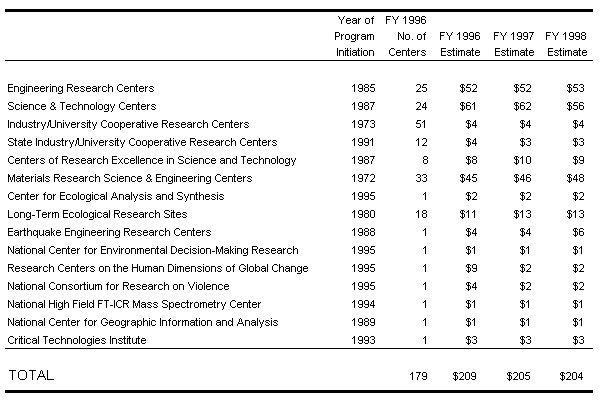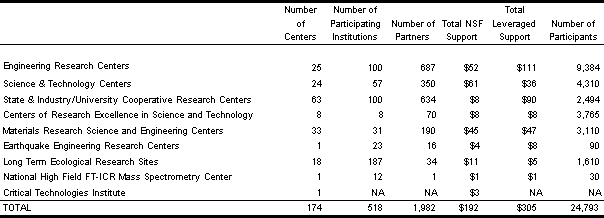
Research Project Support develops intellectual
capital through support for researchers in disciplinary and cross-disciplinary
fields of research, emphasizing the discovery of new knowledge
as well as contributing to education and training. Research Project
Support includes funding for both Research Projects and Centers.

Research Projects
FY 1998 support for Research Projects
totals $1,668 million, an increase of about $50 million, or 3.1
percent, over FY 1997. Support for Research Projects includes
funding for researchers as well as postdoctoral associates and
undergraduate and graduate assistants. Funds are provided for
items necessary for performing research, such as instrumentation
and supplies, and for related costs for travel and conference
support. NSF seeks out and supports excellent proposals from
groups and regions that traditionally have not fully participated
in science, mathematics, and engineering.
The requested increment will intensify
NSF-supported research efforts in such areas as: microbial biology;
plasma science and engineering; Human Capital initiative; Life
in Extreme Environments; U.S. Weather Research Program; human-centered
systems such as intelligent human/computer interfaces; human dimensions
of the Arctic system; and initial testing for arctic science applications
of the new U.S. Coast Guard icebreaker Healy. Support for the
Research Experiences for Undergraduates (REU) program, which involves
undergraduate students in research activities, increases by more
than 10 percent.
Knowledge and Distributed Intelligence
(KDI) is a Foundation-wide effort that draws on past advances
made in networking, supercomputing, and learning and intelligent
systems. In FY 1998, NSF plans a focused, multidisciplinary program
of activities in support of KDI research that builds on a base
of related on-going projects.
University/industry partnerships within
an integrated education/research environment will be supported
through expansion of the Grant Opportunities for Academic Liaison
with Industry (GOALI) program. A new Industry-University Environmental
Chemistry Institute will be initiated in FY 1998. In addition,
$50 million will be used to continue support for an NSF-wide instrumentation
program.
Over $100 million in support is targeted
for young investigators and for increasing participation of women
and minority researchers. The Faculty Early Career Development
(CAREER) program, which was initiated in FY 1995, will increase
by 21 percent to almost $83 million in FY 1998. CAREER supports
junior faculty within the context of their overall career development
and combines, in a single program, the integrated support of quality
research and education.
The Experimental Program to Stimulate
Competitive Research (EPSCoR), a State-NSF partnership, will continue
to support improvements in academic research competitiveness.
In FY 1998, funding for EPSCoR totals more than $38 million.
Linkages between EPSCoR and other NSF-supported research and
education and training activities is expected to result in an
additional $8-10 million directed to research in EPSCoR states.
The Small Business Innovation Research
(SBIR) program is supported at the mandated level of at least
2.5 percent of extramural research. The program will total approximately
$54 million, an increase of about $3 million over the $51 million
for SBIR in FY 1997.
Centers
NSF supports a variety of individual
centers and centers programs. The centers play a key role in
furthering the advancement of science in the U.S., particularly
through their encouragement of interdisciplinary research and
the integration of research and education. While the programs
are diverse, the centers share a commitment to:
The centers and center programs are
listed below.

FY 1998 support for centers is $204
million, a decrease of less than 1 percent from FY 1997. NSF
supported 179 centers during FY 1996. In FY 1998, funds realized
from the planned phase-down of six Engineering Research Centers
will be used to initiate three to four new Engineering Research
Centers. In addition, there will be up to three new Materials
Research Science and Engineering Centers supported. NSF will
also prepare for the possible initiation of a new Science and
Technology Center competition.
In order to move into new areas of science,
some existing programs will be eliminated or phased out. The
Land Margin Ecosystems Research program in the Geosciences and
Biological Sciences Activities will be phased out in favor of
a collaborative effort to support up to two new coastal Long Term
Ecological Research (cLTER) sites. There is also a planned phase
down in support of several of the State Industry/University Cooperative
Research Centers in the Engineering Activity. Funds will be redirected
to support small group research efforts aimed at strengthening
university-industry-state partnerships.
Additional information for selected
centers supported by NSF is provided below:

Number of Participating Institutions:
all academic institutions which participate in activities at the
centers.
Number of Partners: total number
of non-academic participants, including industry, states, and
federal agencies, at centers.
Total Leveraged Support: funding for
centers from sources other than NSF.
Number of Participants: the total number
of people who utilize center facilities; not just persons directly
supported by NSF.
 Back to the Key
Program Functions page
Back to the Key
Program Functions page